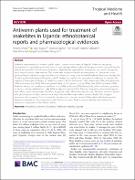| dc.identifier.citation | Omara, T., Kagoya, S., Openy, A., Omute, T., Ssebulime, S., Kiplagat, K. M., & Bongomin, O. (2020). Antivenin plants used for treatment of snakebites in Uganda: ethnobotanical reports and pharmacological evidences. Tropical Medicine and Health, 48(1), 6. | en_US |
| dc.description.abstract | Snakebite envenomation is a serious public health concern in rural areas of Uganda. Snakebites are poorly
documented in Uganda because most occur in rural settings where traditional therapists end up being the first-line
defense for treatment. Ethnobotanical surveys in Uganda have reported that some plants are used to antagonize
the activity of various snake venoms. This review was sought to identify antivenin plants in Uganda and some
pharmacological evidence supporting their use. A literature survey done in multidisciplinary databases revealed that
77 plant species belonging to 65 genera and 42 families are used for the treatment of snakebites in Uganda. The
majority of these species belong to family Fabaceae (31%), Euphorbiaceae (14%), Asteraceae (12%), Amaryllidaceae
(10%) and Solanaceae (10%). The main growth habit of the species is shrubs (41%), trees (33%) and herbs (18%).
Antivenin extracts are usually prepared from roots (54%) and leaves (23%) through decoctions, infusions, powders,
and juices, and are administered orally (67%) or applied topically (17%). The most frequently encountered species
were Allium cepa, Carica papaya, Securidaca longipedunculata, Harrisonia abyssinica, and Nicotiana tabacum. Species
with global reports of tested antivenom activity included Allium cepa, Allium sativum, Basella alba, Capparis
tomentosa, Carica papaya, Cassia occidentalis, Jatropa carcus, Vernonia cinereal, Bidens pilosa, Hoslundia opposita,
Maytensus senegalensis, Securinega virosa, and Solanum incanum. There is need to identify and evaluate the
antivenom compounds in the claimed plants. | en_US |

